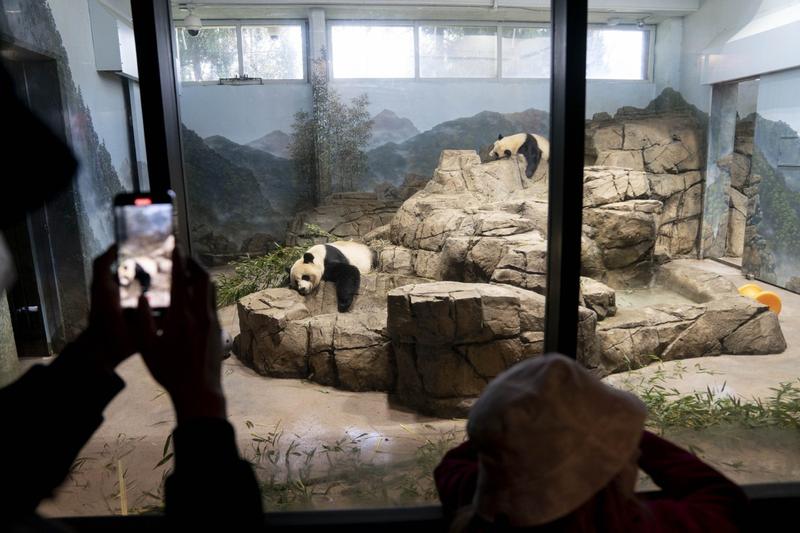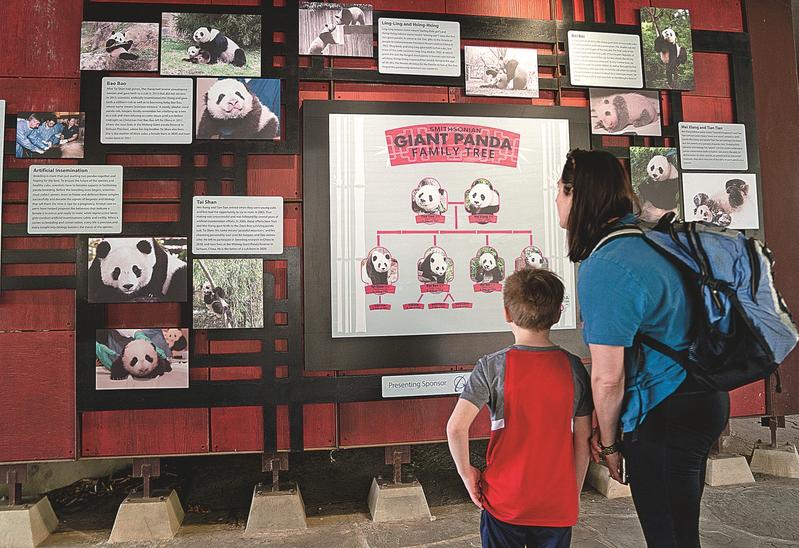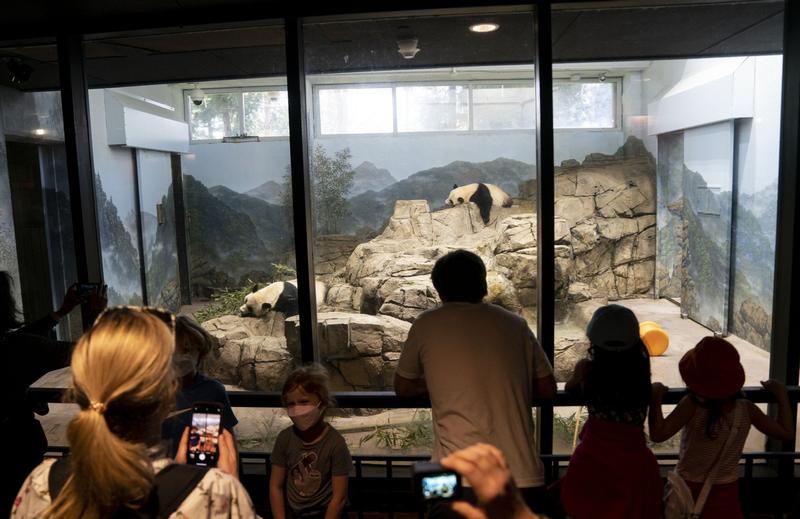 Photo taken on March 16, 2022 shows giant pandas Mei Xiang (left) and Xiao Qi Ji at Smithsonian's National Zoo in Washington, DC, the United States. (PHOTO / XINHUA)
Photo taken on March 16, 2022 shows giant pandas Mei Xiang (left) and Xiao Qi Ji at Smithsonian's National Zoo in Washington, DC, the United States. (PHOTO / XINHUA)
The Smithsonian National Zoo in Washington kicked off a six-month celebration on Wednesday of the 50th anniversary of the arrival of two giant pandas, celebrating the close cooperation between China and the United States in panda exchanges and preservation.
The first pandas from China in the US-Ling Ling and Hsing Hsing-arrived at the Smithsonian National Zoo and Conservation Biology Institute on April 16, 1972.
 Tourists take photos of giant pandas at Smithsonian's National Zoo in Washington, DC, the United States, on March 16, 2022. (PHOTO / XINHUA)
Tourists take photos of giant pandas at Smithsonian's National Zoo in Washington, DC, the United States, on March 16, 2022. (PHOTO / XINHUA)
Brandie Smith, director of the Smithsonian National Zoo said one of the highlights will be a "screening of the film, The Miracle Panda, which is our story of the giant pandas at the national zoo. And we also are going to have an event with the Chinese embassy. The embassy is going to come and provide treats for people as they see the pandas"
"We are going to have six months of celebrations both online and at the zoo. People can come to see the cubs and the mom and dad," Brandie Smith, director of the national zoo, told China Daily.
Annalisa Meyer, the zoo's deputy director of communications, said the celebrations will run through Aug 27. The zoo will hold online events, as well as on-site events on April 8 and 21.
Smith said one of the highlights will be a "screening of the film, The Miracle Panda, which is our story of the giant pandas at the national zoo. And we also are going to have an event with the Chinese embassy. The embassy is going to come and provide treats for people as they see the pandas."
The documentary The Miracle Panda, by the Smithsonian Channel, will be screened for a limited time at the zoo's Visitor Center Theater on April 16 and 17.
Also on April 16, from 9 am to 2 pm, visitors can enjoy lion dance performances, panda-shaped Bao buns and calligraphy demonstrations. They also can speak with the zoo's scientists who study giant panda biology and ecology, and they can watch the pandas receive special treats.
ALSO READ: Chinese pandas celebrating 3rd Lunar New Year at Moscow Zoo
The Giant Panda Family Tree Photo Gallery in the outdoor giant panda exhibit has already been set up, allowing visitors to explore the zoo's successful giant panda breeding program and to follow how cubs born at the zoo contribute to their species' survival in China.
 Visitors look at the giant panda family tree at the Smithsonian National Zoo in Washington on Wednesday. Photos and information about the zoo's giant panda breeding program are being exhibited to celebrate the 50th anniversary of the program. (PHOTO / XINHUA)
Visitors look at the giant panda family tree at the Smithsonian National Zoo in Washington on Wednesday. Photos and information about the zoo's giant panda breeding program are being exhibited to celebrate the 50th anniversary of the program. (PHOTO / XINHUA)
In 1972, then-US president Richard Nixon and first lady Pat Nixon made a historic visit to China. The first lady went to the Beijing Zoo to visit pandas on their second day in China.
At a dinner before they left China, Premier Zhou Enlai told Pat Nixon that China would present the US with two pandas, which surprised and delighted her.
The two pandas, Ling Ling and Hsing Hsing, lived at the national zoo for more than 20 years. Their arrival not only brought warmth and joy to tens of millions of Americans but also launched the US-China giant panda program.
Now the panda couple, Mei Xiang and Tian Tian, and their cub Xiao Qi Ji ("little miracle"), born in August 2020, live at the national zoo.
ALSO READ: Giant panda gives birth to twin cubs at Tokyo's Ueno Zoo
 Photo taken on March 16, 2022 shows giant panda Mei Xiang at Smithsonian's National Zoo in Washington, DC, the United States. (PHOTO / XINHUA)
Photo taken on March 16, 2022 shows giant panda Mei Xiang at Smithsonian's National Zoo in Washington, DC, the United States. (PHOTO / XINHUA)
Mei Xiang and Tian Tian's other three cubs, Tai Shan, born in 2005; Bao Bao, born in 2013; and Bei Bei, born in 2015, were returned to China.
The two pandas, Ling Ling and Hsing Hsing, lived at the Smithsonian National Zoo for more than 20 years. Their arrival not only brought warmth and joy to tens of millions of Americans but also launched the US-China giant panda program
Smith recalled that the males, Bei Bei and Xiao Qi Ji are "more outgoing" than their brother Tai Shan.
"I met these pandas; I know them so well, I remember the moments all of the cubs were born here. And one thing is that we know when they are born that they're going to go to China to be part of the group breeding program," she said.
"So it's almost like any baby. When any baby grows up, you don't want them to stay with you if you want them to go out and to succeed, and so our cubs will go to China, and they will have their cubs and help contribute to the conservation of the species."
Smith said she has been impressed by the cooperation with the zoo staff's counterparts in China.
"I have really loved working with the giant pandas. They're incredible animals to work with and get to know them as a species. But also, one of my favorite parts is it's not just about working with these animals. It has been about working with colleagues in China," she said.
 Tourists take photos of giant pandas at Smithsonian's National Zoo in Washington, DC, the United States, on March 16, 2022. (PHOTO / XINHUA)
Tourists take photos of giant pandas at Smithsonian's National Zoo in Washington, DC, the United States, on March 16, 2022. (PHOTO / XINHUA)
"So working with our scientists and other contributors in China to share knowledge about pandas, their habitat and their culture has really been an incredible experience for me."
READ MORE: Squeaking, hairless and pink: Twin giant pandas born at Madrid Zoo
The COVID-19 pandemic has created obstacles for in-person communications.
"Normally we go to China several times a year, and our colleagues are trying to come here to visit us. With the pandemic, it's been hard because we haven't been able to see each other in person, but the good thing is that we still have emails, video calls and other ways to communicate," Smith said.


